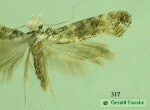Family Tineidae: Cloths moths & allies
| Diagnosis: Head with erect ‘bristly’
vestiture, eyes without hair, labial palpi with stiff lateral bristles,
palpi not recurved, maxillary palpi often visible and folded, five
segmented; fw with Rs4 running to costa,
f/hw with media stem present in discal cell, hind tibiae with 'bristly' vestiture.
Diversity: World wide there are 15 subfamilies, 320 genera, and more than 3,000 known species; at least 49 genera and 112 species in North America; five species, two subfamilies, known from North Dakota. Checklist numbers: 261-326, 387- 434. Biology: Adults may lay up to 200 eggs, some species lariparus (giving birth to up to 60 first instar larvae). Larvae often build portable cases, a few species construct tubes or webbing. Larvae fill a wide variety of niches: scavengers, lichenophiles, algivores, or detritivores. Exotic niches: boring in antelope horns, aged carnivore dung, and algae growing in sloth fur. Some species of economic importance: Cloths moth, Case-making cloths moth, and Carpet moth.
|
|
| Further reading:
Davis, Donald R. and Gaden S. Robinson, Chapter 7. The Tineoidea and Gracillarioidea in Kristensen, Neils P. ed. 1999. Lepidoptera, moths and butterflies. Part 35, Vol. 1 in Handbook of Zoology. Maximilian Fischer ed. Walter de Gryter, New York. 491 pp. Forbes, William T. M. 1923. Tineinae, pp. 122- 140, in Lepidoptera of New York and neighboring states. Part I. Primitive forms, Microlepidoptera, Pyraloids, Bombyces. Cornell Agric. Exp. Sta. Mem. 68: 729 pp. Scoble, Malcom J. 1992. Chapter 11. Lower Ditrysia, pp. 225- 254 in The Lepidoptera: form, function, and diversity. Oxford Univ. press. 1982. 404 pp.
|
|
